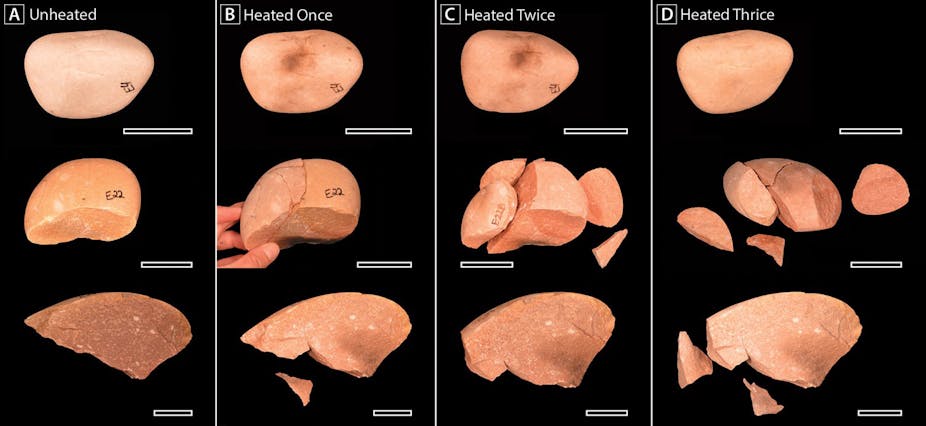Fire was probably first used by humans one million years ago. It was a valuable resource for light, warmth, and keeping predators at bay. It also opened up new culinary avenues: roasting meat, fish, shellfish and vegetables on charcoal or in the fire was probably early modern humans’ main cooking technique.
Between 50 000 and 30 000 years ago, people started producing large quantities of heat-affected rocks. Researchers think this signals the start of boiling and intensive bone grease rendering. These cooking techniques used heated rocks to warm up liquid, adding dishes like broth and soup to the menu. Rocks were also probably used as primitive frying pans, placed in or next to fires, and as heating elements to bake or fry food in earth ovens.
One of the ways to recognise which rocks were used for cooking is by mapping colour changes. Many rocks rubefy – develop shades of pink or red – during heating; others whiten or darken.
But it’s difficult to describe these colour changes in a way that makes it possible to compare the colours of different rocks in different studies. One researcher’s “dark pink” is another’s “purple”.
In a new paper in the Journal of Field archaeology, my co-author Sarah Wurz and I have taken some steps towards addressing this issue.
We heated rocks in experimental campfires and compared different colour recording methods to describe the rocks. We wanted to find the best method to describes rocks’ colour changes, and which also allows statistical analyses of these changed. This baseline study means that in future, researchers can more easily compare heated rocks from different studies and areas.
This is important because it helps researchers to understand the use and development of human cooking techniques. It can also help us understand other uses of heated rocks, such as in steam baths.
The sample rocks
One set of the rocks used in this research came from a site in South Africa’s Eastern Cape province. The Klasies River main site was first excavated in the late 1960s, then again between 1984 and 1995.
Earlier excavations revealed that small groups of early modern humans visited Klasies River many times between 120 000 and 40 000 years ago, and sometimes stayed for a few days at a time. The groups included both children and adults; they collected or caught and ate seafood, land animals, and plants. The remains of their fires and burning marks on bones showed that they also cooked their food.
My co-author, Sarah Wurz from the University of the Witwatersrand, is directing a new excavation phase at Klasies River main site. As part of her team, I’m excavating and analysing the site. Given my specialisation – fire use and experimental archaeology – I’m particularly interested in one of our finds: fractured and broken quartzite fragments that appear rubefied. Could these rocks have been heated, perhaps for use in cooking?
I knew from other studies that quartzite in other areas changed colour when exposed to heat, but it was difficult to compare those results to the rocks from Klasies River. The problem was that colours were described with words and there were limited photos. I could not be sure if the dark red or light pink described in the literature was similar to the colours I was seeing in my experiments. I also did not know how quartzite from the Klasies River area reacted to heat.
I decided to try and replicate the potentially heated rocks. So we collected quartzite cobbles at the beach and heated them in controlled fires. I recorded the temperatures during the fires and could see that some of the rocks in the fires fractured and changed colour during the experiment. Many of the samples did not change after the first heating episode. Some samples didn’t change even after repeated heating.

This was just part of my work: I also tried different approaches to see how best to quantify the changes to the rocks.
Technology and statistics
Before the experiments, and after every heating episode, I recorded the colour of the quartzite samples. I noted the Munsell colour value of each sample. This provides a standardised colour chart that can be used to describe colours, which makes it a little easier to compare colours across studies. Then, using statistical software, I converted the Munsell colour values to numerical values. Lastly, I photographed all the samples in controlled light before the experiments started and after every heating episode.
The photos were imported into Adobe Photoshop software, where I could record the digital RGB colour values of each sample. We could then conduct statistical analyses of the converted Munsell values and the digital colour values. I used the same methods to record colours of selected archaeological samples and to analyse them.
The digitally recorded colour values proved to be the best way to distinguish between the unheated and the repeatedly heated samples.
This process had two results. The first was that I was able to answer my questions about the Klasies River rocks. The quartzite from this site fractures, breaks and changes colour when heated in a campfire. It had to be quite close to the heat, and some samples needed to be repeatedly heated before they changed.
We could also show that the archaeological samples were probably repeatedly heated. This could, for example, have happened if the rocks were placed around the campfire and exposed to several fires. This find represents one of the earliest examples of using stones for heating or possibly cooking.
The second result has consequences far beyond this single study. I could show that digital colour values could be used to distinguish between unheated and repeatedly heated rocks, even when few changes were perceived by the naked eye. This provides a means to better identify heated rocks. Digital colour values also provide a measurement that is fairly independent of the researchers and allows us to compare rocks from different areas and studies.

